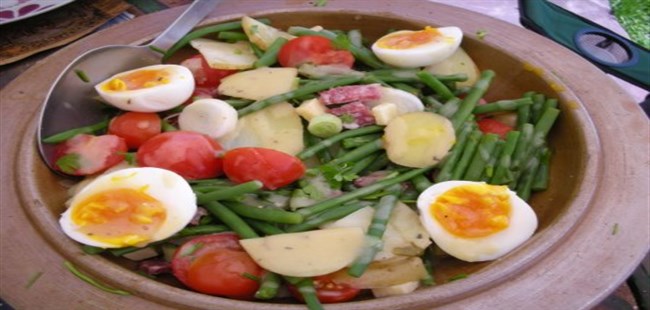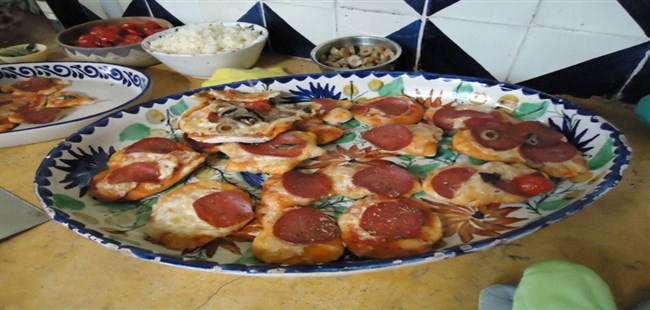The main reason for cooking food is to make it palatable and easily digestible. Different cooking methods have varying effects on foods, and it is important that you choose a suitable cooking method for each type of food. Rapid boiling, for instance, helps retain the color and texture of fresh vegetables, but tough cuts of meat need slow simmering to make them tender.
Cooking methods may be combined, as in braising, in which quick frying and slow stewing brown and tenderize meat.
Healthy Cooking
The way in which food is cooked plays an important role in determining the food’s nutritional contribution to our diet. Whenever possible, choose low-fat cooking methods, or cook with oils that are low in saturated fat, and use methods of cooking that retain nutrients.
Stir-Frying
Adding in stages: When stir-frying mixtures of vegetables, place each vegetable in the pan separately to maintain the heat. Add the slowest-cooking first and the fastest-cooking last.
Sealing food quickly Use less oil or fat for stir-frying than you would normally use for shallow frying so that the surface of the food seals quickly. Add just enough oil to the pan to coat the food lightly.
Boiling
Reusing cooking liquids Refrigerate liquids that have been used for boiling food since these contain flavor and nutrients. Add to gravies, sauces, soups, or stocks.
Conserving nutrients: To preserve the vitamins when boiling vegetables, bring the water to a rolling boil before adding the vegetables to the pan. Bring back to the boil quickly, and keep the heat high until done.
Steaming
Cutting same-sized pieces To ensure that pieces of food cook evenly and within the same period of time when steaming, cut them all to approximately the same size.
Making a bundle: Retain the nutritious juices from steamed foods by wrapping food in bundles of baking parchment or aluminum foil before placing in a steamer. Pour the juices over the food to serve, or add to a sauce.
Vegetables
Most vegetables retain their color, texture, and flavor best if they are cooked quickly and lightly. Many different cooking methods can be used. Vegetables taste best if served as soon as possible after they have been cooked.
Potatoes are very versatile and respond well to most cooking methods. To a great extent, the variety of potato determines which cooking method you use. For instance, grainy-textured potatoes are good for baking, roasting, and mashing, while waxy types are best boiled.
Ensuring Success
• Baked potatoes: To speed up the cooking of baked potatoes, push metal skewers through their centers to conduct the heat. Alternatively, parboil the potatoes for 15 minutes before baking.
• Mashed potatoes: Add a little hot milk (not cold) to mashed potatoes to give them a really fluffy texture. Warm the milk in a microwave for speed.
• Boiled potatoes: Prevent old potatoes from blackening by adding a squeeze of lemon juice or a teaspoonful of vinegar to the cooking liquid.
Crisping Potatoes
Roughing up the surfaces: For crisp roast potatoes, cut the potatoes into chunks, parboil, and drain. Shake the covered pan to roughen the surfaces of the potatoes, then roast as usual.
Keeping Potatoes: Hotdish towel to cover mashed potatoes and keep them hot before serving. The towel will absorb excess moisture, keeping them fluffy and dry.
Most green vegetables are rich in vitamin C, and they should be cooked quickly in the minimum of liquid to retain this very important nutrient. If you boil greens, keep the cooking water and add to gravies or soups. Alternatively, use water-free methods such as stir-frying.
Cooking Cabbage
Instead of shredding cabbage, cut it into slim, portion-sized wedges and steam the wedges until just tender. The wedges will retain more nutrients than shredded cabbage and look decorative.
Cooking Asparagus
Arrange asparagus spears in a wide, shallow dish with their pointed tips to the center. Add 3 tbsp (45 ml) water, cover, and cook on High for about 12-14 minutes per pound (500 g).
Improving Greens
• Cabbage: Braise cabbage in a little stock instead of water. Shred finely, and cook with just enough stock to moisten, shaking the pan often.
• Spinach: To remove excess moisture from cooked spinach, put spinach into a colander, and press with a potato masher, or press between two plates.
• Napa cabbage: Shred the coarse outer leaves of Napa cabbage and stir-fry. Save the tender leaves for salads.
• Brussels sprouts: Cut crosses through the stems of Brussels sprouts for even cooking.
Enchancing Flovor
Most vegetables are best cooked lightly to and adding ingredients such as herbs, it retains their flavor, color, and texture. By possible to add interest to, and enhance the experimenting with different cooking methods flavor of, even the most ordinary vegetable.
Using Onions
Frying onions: To obtain a sweet, caramelized flavor, fry onions slowly in butter with a pinch of salt until they are a rich, golden-brown color.
To add the flavor of onion to savory dishes without including sliced or diced onion pieces, squeeze half an onion on a lemon squeezer to extract the juice. Add the liquid to the dish.
Using Fruit Juices
Sprinkling lemon juice: Fresh lemon juice will pep up the flavor of most vegetables. Use it instead of adding salt for people on low-salt diets.
Add a rich, sweet flavor to plain carrots by cooking in orange juice instead of water. Braise small, whole, new carrots until tender with just the juice of an orange and a pat of butter.
Adding Spices
Spicing leeks Add a spicy pungency to leeks by gently sauteing them until soft in a little butter with a pinch of ground coriander and cumin.
Sprinkle freshly grated nutmeg overcooked spinach, parsnips, or potatoes just before serving. The heat of the vegetables will bring out the full, warm, spicy aroma and flavor of the spice.
Maximizing Flavor
• Brussels sprouts Instead of boiling Brussels sprouts, shred them finely and stir-fry lightly in a little olive oil to retain flavor and crispness.
• Beets “Wrap beets in foil, and bake instead of boiling to preserve flavor and color. Trim the tops of the beets, and wrap in buttered foil. Bake in a moderate oven for 1-2 hours.
• Peas and snow peas add a sprig of fresh mint when boiling peas or snow peas.
• Tomatoes Add a pinch of sugar to cooked tomatoes and homemade tomato sauce.
Using Leftovers
• Grilling with cheese: Arrange vegetables in one layer in a heated dish. Cover with thin slices of Gruyère, and grill.
• Making potato pancakes: Mix mashed potatoes with grated onion, then shallow-fry in cakes until golden.
• Making fritters: Dip broccoli or cauliflower florets in the batter. Then deep-fry in hot oil until they are a golden color.
• Tossing salads: Dice cooked, mixed vegetables, and toss with mayonnaise and lemon juice. Serve cold as a salad.
• Making Soup: Purée cooked vegetables with leftover gravy, stock, or milk to taste.
Time Saving Tip
Making vegetable bundles: Wrap prepared vegetables in buttered foil, and cook in the oven in a roasting pan with roast meat for the final 30-40 minutes of cooking time. Add sprigs of fresh herbs to the bundles, and season with salt, and pepper. Seal the bundles firmly to keep in the flavors.
Adding
Vegetables are versatile ingredients that will contribute significantly to a healthy diet, but if they are always cooked in the same way they lose their appeal. Be creative by combining vegetables with other ingredients in unusual ways and using different cooking methods.
To serve carrots and zucchini in an unusual way, and to cook them quickly, slice them into thin ribbons by using a vegetable peeler instead of a knife. Steam or stir-fry the ribbons for 2-3 minutes or until they are tender.
Cooking Creatively
• Making “confetti”: Use the coarse shredder blade of a food processor to shred evenly vegetables such as carrots, peppers, zucchini, or celery root. Cook together in a quick “confetti” stir-fry,
• Adding bacon: Transform cooked green beans into a dinner-party dish by tossing with crushed garlic, golden- fried crumbled bacon, and chopped tomato.
• Pureeing eggplants: Serve eggplants as a puree. Bake them whole in their skins for about 45 minutes in a moderate oven, or until tender. Scoop out the flesh, mash with a fork, and add salt, pepper, and olive oil to taste.
Adding Texture
Sprinkling with seeds: To add an interesting texture to plain, cooked vegetables and increase their nutritive value, sprinkle with a few lightly toasted sunflower, pumpkin, or sesame seeds, or add chopped nuts just before cooking.
Correcting Mistakes
If you have overcooked vegetables, there is no need to discard them, since they can usually be revived easily, or presented in a different way in order to disguise the mistake. You may even find that the end result is better than what you had originally intended.
Pureeing Vegetables
Rescue boiled carrots, spinach, or peas that have overcooked by serving them as a rich, creamy purée. Put the vegetables in a food processor, and purée until just smooth. Add a few tablespoonfuls of cream to taste.
Reviving Mash
If potatoes intended for mashing are overcooked or if they have collapsed, whip an egg white until stiff, and fold it carefully into the mashed potatoes. Pile the mixture into a dish, and bake in a hot oven until golden.
Rescuing Disasters
• Counteracting salt: Rescue over-salted vegetables by pouring boiling water over them. If they are still too salty, stir them gently in a few tablespoonfuls of cream.
• Reducing toughness: If mushrooms have become tough and dried out, add a few tablespoonfuls of red wine. Let the mushrooms soak for 10 minutes, then bring to a boil. Stir in a little cream.
• Making soufflés: Mash overcooked cauliflower or broccoli, and mix in a can of condensed soup and three egg yolks. Fold in three whipped whites. Bake in ramekins in a hot oven for 20 minutes.







